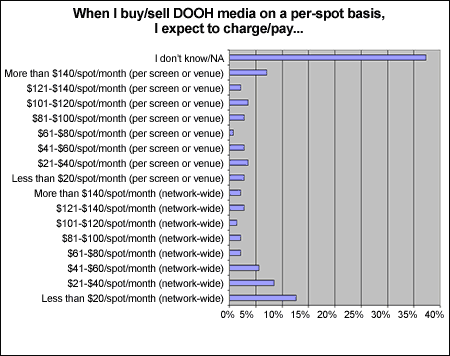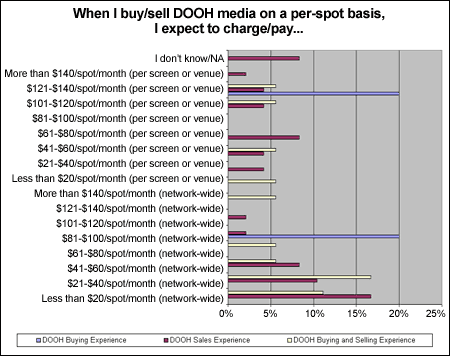Buying DOOH ads on a per-spot or per-screen basis
To begin with, when asked "When I buy/sell DOOH media on a per-spot basis, I expect to charge/pay...", our respondents said the following:

This chart gives us a nice idea of what respondents feel is a fair price to pay for... well... something. While plenty of people -- nearly 40% -- outright admitted that they didn't know how to price DOOH media this way, others were more than happy to pick some numbers that they felt reflected reality. Unfortunately, there was a flaw in the methodology that prevents me from drawing a conclusion as to the typical pricing of DOOH media on a per-screen or per-spot basis. In short, responses like "$21-$40/spot/month (per screen or venue)" and "$21-$40/spot/month (network-wide)" can be taken to mean different things. When I wrote up these choices, I was making a distinction between deals where a buyer is allowed to purchase spots on individual screens of a network a la carte versus deals where an advertiser has to purchase spots on every screen in a given network. However, survey-takers could have interpreted the "across the whole network" options to either mean "I'd pay this much per screen when I buy ads on every screen in the network" or "I'd pay this much in total to have my ads play on every screen in the network." That's obviously a pretty important distinction, and even if we knew that most responses were based on the latter interpretation, it'd still be impossible to figure out a per-spot, per-screen price -- since network sizes vary from a single screen up to the thousands.
So, looking at it from any one of several different directions, maybe the average cost per spot is about $49/screen/month. Or maybe it's $90/screen/month across the whole network (whatever that means). Over the years, I've anecdotally heard everything from $10/screen/month to well over $200, so I really don't have much of a feel for which of these numbers might be most indicative of today's market. Of course, that position might turn out to be the most accurate: as multiple respondents noted in their comments, DOOH advertising networks are so diverse and heterogeneous that there probably isn't a mean or median price that reflects what most spots on most networks truly sell for.
Comparing the perceptions of buyers and sellers
With all that said, it's interesting to observe that buy-side respondents tended to skew toward higher price ranges, while sellers perceived a much wider range of pricing options:

As we discussed earlier in this article series, it's possible that our buy-side survey takers came exclusively from big agencies accustomed to buying premium placements on big networks for big fees. Or, it could be because we only had a handful of exclusively buy-side respondents, and it's easy for a small sample size to skew the results. Whatever the case, the dynamic that I expected to see -- namely, DOOH buyers trending towards lower prices and DOOH sellers trending high -- didn't show up. So, we can take comfort in knowing that the overall data isn't significantly biased toward one group or the other.
Sadly, my shoddy survey-putting-together skills mean that for now, we still don't have a good answer to the question of how to price DOOH media on a per-screen or per-spot basis. Still, I continue to like this model a lot. It's simple, it's easy to explain, and when pitched by the right networks to the right audience of advertisers, it offers an equitable way to value screen time without the need for any fancy metrics or methodologies.
Does pay-per-screen or pay-per-spot pricing still have a place in today's DOOH advertising world? Leave a comment with your thoughts! (If you're viewing this in your email or RSS reader, click through to /blog to comment.)

 Subscribe to the Digital Signage Insider RSS feed
Subscribe to the Digital Signage Insider RSS feed
Comments
RSS feed for comments to this post